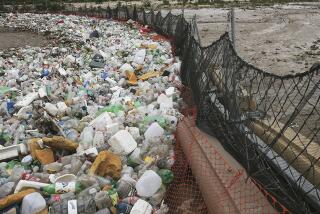Copper Firm Balks at Terms of Bay Cleanup
- Share via
A National City copper-transport terminal accused of polluting San Diego Bay has challenged the state’s request that it return the bay to the condition the state says it was in before the terminal opened, a state engineer said Thursday.
David T. Barker of the California Regional Water Quality Control Board said Paco Terminal Inc. has acknowledged that there is a high copper level near its plant but that the firm contends that the proposed cleanup is too strict.
Barker said his office hopes to meet with the company later this month to work on a compromise. Neither the general manager for Paco Terminal nor a company lawyer could be reached for comment Thursday.
The water quality control board, which enforces state and federal water laws in the San Diego area, in July blamed the company for what environmental officials said are among the highest known copper contamination levels in California waters.
The board said copper levels near the terminal had increased thirteenfold in the six years since Paco began operating its terminal. The board gave Paco one month to measure the extent of the contamination and come up with a schedule for cleaning it up.
Environmental and health officials said the copper levels were sufficient to kill marine life but posed no threat to human health.
Barker, who is supervising the case, said Paco disagreed in a report to the board last week that the copper levels should be reduced to 110 milligrams of copper per kilogram of sediment--the level the board says existed in 1979.
Paco suggested that the post-cleanup levels should be higher, Barker said. He said the company based its position on private industry data that suggested that the 1979 levels varied widely, reaching as high as 300 and 1,000 milligrams per kilogram.
“I haven’t really made up my mind one way or the other whether we’re going to stick with the 110 or go with a higher number,” Barker said.
Paco also contended that the copper is not highly soluble and that most of it is remaining on the bottom of the bay, Barker said.
“Initially, our position is that we’re probably looking toward considering the total amount of copper and not giving any credit for what is leachable and what is not,” he said. “Our position is that the ore shouldn’t be in the bay.”
State samples showed copper levels as high as 141,000 milligrams per kilogram and an average level of 13,717, the board told Paco in July. A consultant retained by Paco then did its own sampling and found levels ranging from 2,300 to 28,000 near the terminal, Barker said.
Farther away, Paco found significantly lower levels: From 47 to 372 at distances of 250 to 750 feet from the pier face, and 29 to 45 at distances of 1,500 to 3,000 feet, Barker said. Five miles north and south, Paco found concentrations ranging from 118 to 325, Barker said.
“That brings up the point that there are probable sources of copper contamination in San Diego Bay other than Paco,” he said. Those could include shipyards that work with copper.
According to the board, Paco ships 140,000 tons of copper ore through its terminal annually. Barker has said he suspects that the pollution occurred when wind or rain washed the powder off the company’s pier on Terminal Avenue into the bay.
More to Read
Sign up for Essential California
The most important California stories and recommendations in your inbox every morning.
You may occasionally receive promotional content from the Los Angeles Times.










